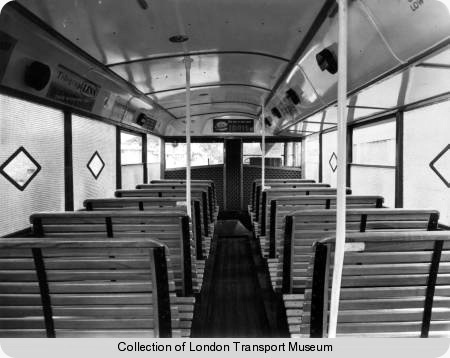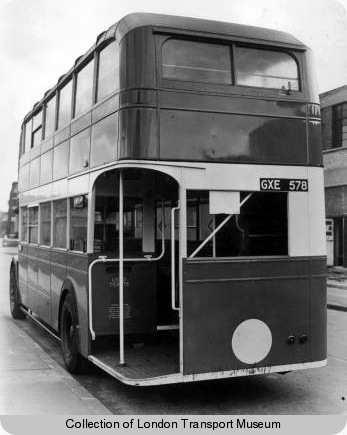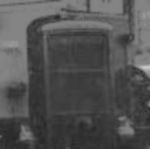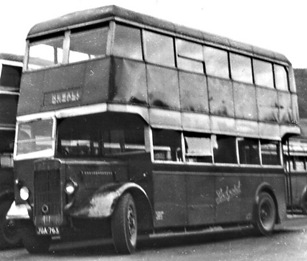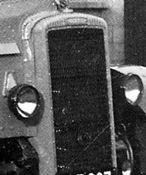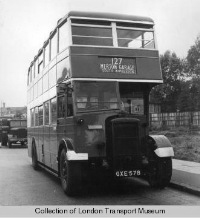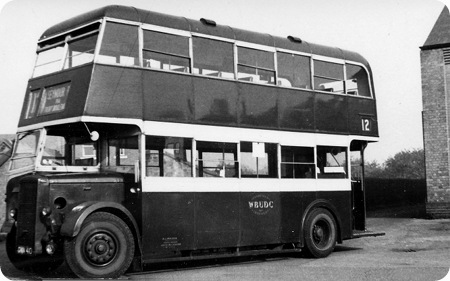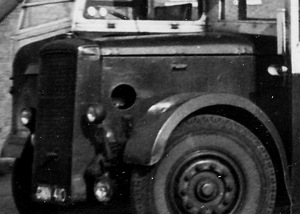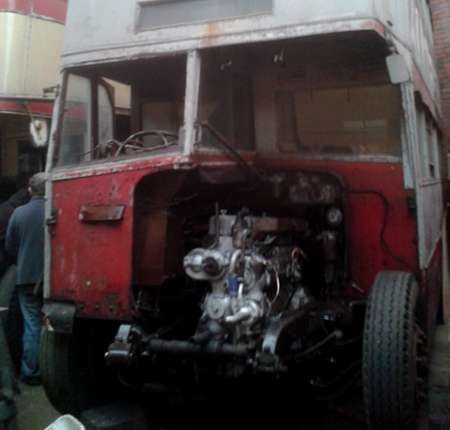Portsmouth Corporation – Daimler CWA6 – CTP 180 – 179
Portsmouth Corporation
1944
Daimler CWA6
Crossley H30/26R (after re-bodying in 1955)
The austerity Daimler CWA6 parked behind my earlier posting of Portsmouth Corporation’s Leyland Cheetah provoked some discussion and Chris Barker asked if anyone had a photo of one after re-bodying. Here is a nice one, shiny, shorn of adverts and looking fairly clean, despite the wet day. The bus is parked outside the art deco façade of Southdown’s Hilsea East Depot (outskirts of Portsmouth) and is facing in completely the wrong direction for the suburb of Paulsgrove. This, and the absence of passengers and driver, make me suspect that the bus was being used for business purposes, rather than being in service. Michael Hampton says that grey roofs were repainted white between 1959-1961 and the lack of adverts could suggest that the photo was taken not long after re-bodying. Although the different height of each headlamp slightly spoils the appearance, the design is quite pleasing.
Was this body design unique to these nine buses?
Photograph and Copy contributed by Chris Hebbron
Not really a Crossley body at all… just a Park Royal body built at a subsidiary company, a bit like the 30ft. Glasgow BUTs were built by Crossley to Park Royal drawings.
Very nice though!
John Whitaker
Yes, the tiny ventilators in the middle of the upper edge of the top deck windscreens cry out "Park Royal" don’t they?? This body has many outline similarities to the one fitted to the AEC Regent V demonstrator 88 CMV. The Portsmouth Daimler is a very handsome machine and the livery most dignified.
Chris Youhill
As I’ve said, many times before, when Park Royal were busy and needed more capacity for metal framed bodies, they farmed it out to their subsidiaries. Roe benefited from this and it kept the Crossley factory open for about eight years after the last DD42 and SD42 had been delivered. They were not just Park Royal designs, they were built on Park Royal frames.
David Oldfield
Remembering this is 1955, we are still with hinged driver’s door with those funny windows, including one for sticking a leather covered arm out- no trafficators of any sort, even then… and a starting handle…?
Joe
I think the last genuine Crossley rebodies were the 13 for Bradford in early 1952, built on reconditioned AEC 661T and Karrier E4 chassis. These were quite similar in outline to the CWG5 rebodied for Lancaster in (1951?)
Crossley "cleaned up" the body outline circa 1950 by omitting the wavy window features as shown on their designs for Oldham etc. on their own chassis.
I believe that most Crossley bodies from 1937/8, were built on MCW frames, or a variant of these, the original designs being for Manchester on Mancunian, TD4/5 or COG5 chassis. Details would be of interest if anyone knows.
John Whitaker
John, you’re absolutely correct. Crossley bodies – pre AEC/ACV ownership – WERE on MCCW frames.
Manchester were Crossley’s biggest customer and, as much as anything, having MCCW frames was a Manchester idea to help standardise bodies. It didn’t harm them that MCCW were the best quality metal frames available at the time. The peculiar window line was to give structural strength to a body, specified by Manchester Corporation, with a "self-supporting" platform.
[Colin Bailey was poached from MCCW by Leyland when their metal frames proved such a disaster and went on to provide Leyland with world beating design and quality in their bodies.]
Park Royal frames were introduced, and eventually replaced the MCCW, after AEC/ACV took over in 1948.
David Oldfield
I will say that the driver’s door, with its curved glass insert shape is a feature of Park Royal bodies of the period, and also of the immediate post-war Weymann bodies, usually the ones with flared skirts.
Chris Hebbron
The picture shows the bus at Hilsea Southdown Garage, and it is at the southern terminus of route 21, shown on the screen as "Hilsea Lido". Passengers have alighted, the screen has already been changed for the return to Paulsgrove, Hillsley Road, but the bus has yet to turn to face northwards to take up its next journey. The 21 route was first introduced in 1955 as a feeder service from a newish area of the Paulsgrove estate to Hilsea, where passengers could change to other services onward into Portsmouth city. These Daimlers were frequent performers on it (although all 9 certainly would not have been required!). The bus is certainly working the route shown on screen. The route was the first Portsmouth Corporation motorbus route to have a number identifier (rather than a letter), and the first for many years to be the same in both directions. From c.1930, tram/trolleybus routes were numbered, eg outward "1", return as "2", and motorbus were lettered outward as "A" and return as "B". When the trolleybuses finished in 1959-1963, all motor bus routes were redesignated from letters to numbers, although a significant amount had the paired numberings continued (e.g. G/H became 9/10). This was helpful in order to identify the direction of the several circular or loop services which were a feature of Portsmouth operations, given its geographical location as an island. I suspect that the picture shown was taken not long after both the introduction of route 21, and the return to service of the rebodied Daimler. The final clue to that is the gilt-edged fleet number on the front dash. This is to a large style, standard on early post-war to 1950’s. By c.1958, the same style gilt-edged numbers were being applied, but in a smaller size. The 21 route was absorbed into a converted trolleybus route (3/4) in September 1960 when this was converted to motorbuses, and extended from Cosham to Paulsgrove. The all-Leyland PD2/10s (58-82) then became the most frequent performers on this route. First Hampshire still operate a route 3 (uni-directional numbering) from Southsea to Paulsgrove via Fratton, but it serves a different area of Paulsgrove now. Sorry, lots of minute detail here, but some might find it of interest.
Michael Hampton
Many thanks to Chris Hebbron for posting this, I knew instantly that I have never seen a picture of one of these before. It is indeed a pleasing design but I’ve always felt that any bus so treated, not just Daimler but some others, would have benefitted from improved front wings to cover the dumb irons/springs in to give them a much more ‘post war’ look. In fact, one wonders why some manufacturers didn’t offer full width bonnet conversion kits!
Chris Barker
Thank you David for your Crossley clarifications, Much appreciated…I always thought the "funny windows" were just a fashion fad.
Amazing too, the difference in Leyland build quality after Colin Bailey was poached from MCCW. As well as with EEC metal bodies, Burnley C and N joint committee had all sorts of problems with their Leyland "V" fronts, and Ledgards had to rebody theirs as you probably know.
Which other fleets had severe problems with these early Leyland bodies…do we know?
John Whitaker
More to the point, John, who didn’t have problems with their Leyland V front metal-framed bodies?
Ironic, therefore, that Portsmouth was a rare example of a fleet keeping such bodies until the vehicles were withdrawn. [I cannot, however, remember whether there was any substantial rebuilding of the original bodies to keep them going.]
David Oldfield
I believe that the cost of rebodying resulting from the defective Leyland products was, quite rightly, borne by the manufacturers themselves – I cannot imagine the immortal Mr. Samuel Ledgard settling for anything less !!
Chris Youhill
Further to my last post ref: Leyland "V" front metal bodies, but still on the Portsmouth theme: PCT had batches of "V" front and EEC metal bodied TD4s.
Both of these types had given other operators problems of some magnitude, which is well documented elsewhere. Strange then, that PCT got such long lives from theirs!
Were PCT involved in major overhauling these buses in their early careers?
They certainly did not return to English Electric, or Leyland in pre war years , changing to Cravens, where a previous post hinted at body problems on the Titans. The AEC trolleys lasted well though (Craven).
John Whitaker
David Oldfield’s statement that Park Royal frames replaced MCCW when ACV took over is completely at odds with the information in the "Crossley" tome by Eyre, Heaps and Townsin, according to which ALL Crossley postwar bodies used Crossley’s own frames until the Park Royal design was imposed in 1954/5.
The Crossley metal framing system, which had been in slow development since 1937, came to fruition in 1944, when a prototype body was produced to a one-off design. This was intended to be fitted to the prototype DD42 chassis, but in the event a body swap took place and it ended up in obscurity atop a prewar Mancunian chassis in the Manchester fleet. Meanwhile Manchester was working on a new body design, with help from MCCW in the area of the platform supports as mentioned by David. The two things came together from 1946 onwards, with Crossley building more than half of Manchester’s 710 postwar standards using their new framing system, as well as adopting the Manchester design as the basis of its offerings to the outside world.
In 1948 Crossley produced a new design for Liverpool, and with further development and customised variations this became Crossley’s standard offering until 1954, again using Crossley frames.
Peter Williamson
The bodywork on the Portsmouth Daimler closely resembles the bodywork of Rotherhams last Crossleys delivered in 1952. It is both pleasant to look at and a comfortable ride. One of the Rotherham Crossleys is at the Science Museum collection at ?Wharton. It was for a number of years in the care of Leicester and was used on their open day in 1982 when they withdrew their last rear loaders. Also used was an ex JMT Leyland TD1 in Halifax livery and re-registered MJX 222J (I think but I may be wrong on that one)
Chris Hough
In my defence, Peter, what I said was "…..eventually replaced the MCCW, after AEC/ACV took over in 1948."
This comment is true. I didn’t say, or mean to imply, that it happened immediately. If that it how it was read, I apologise for the ambiguity. I am very aware of the Liverpool variation as Sheffield had four of a "Liverpool" batch of Crossleys diverted to them in 1949 – and of course there were numerous Regent IIIs to this design.
David Oldfield
Apology unnecessary, David. I was just rather concerned that John might get the idea that there were no Crossley-framed Crossley bodies at all, whereas in fact they accounted for most of the postwar output. I am very interested in Chris’s observation of a resemblance between the Portsmouth rebodies and the last Rotherham Crossleys, because (according to the Crossley book) the former are Park Royal designed and framed, and the latter are Liverpool-style bodies with Crossley frames. I suspect some cross-pollination of features, with late Liverpool bodies incorporating PRV rear domes, and possibly the design of certain PRV (and Roe-built) upper deck front windows having come from Crossley/Liverpool practice.
Peter Williamson
Thank you, Michael H, for supplying the supplementary information of which I was unaware. At Hilsea, even then, it must have been a challenge for the driver to cross from nearside to the third lane within a 100 yds, then turn around into the 3-lane Northern carriageway and work his way across to the nearside lane again!
I said on the Leyland Cheetah submission that photos of the Portsmouth’s Daimler CWA6’s with their austerity Duple bodies are very rare. However, I have come across a rear-view photo of one in the North End Depot, showing that PCT retro-fitted a rear blind display sometime before 1949/50. Here is the link to view it.
Chris Hebbron
In the previous comments, John Whittaker asks if PCT were involved in rebuilding any of its EEC or Cravens bodied vehicles. The answer is yes, they certainly were.
My main source of information is the Portsmouth fleet list produced in 1964 by the Worthing Historical Commercial Vehicle Group. Here are some details –
Leyland TD2/EEC of 1933. Batch of 12 (16-27). Two withdrawn for tower wagon conversion, 1952, and three withdrawn 1953 for open-top conversion but never carried out, and scrapped later. The other seven remained in service until 1958, a very creditable 25 years’ service. The WHCV list does not mention CPPTD rebuild for this batch, but a photo in "Fares Please" (Eric Watts, 1987) p.78 shows TD2 No 25 stripped down for rebuild alongside one of the TD4/EEC (115-126 batch) on which renovation has been completed. The caption dates the photo to 1950.
Leyland TD4/EEC of 1935 Batch of 12 (115-126). Again, the WHCV list does not mention any rebuilding of this batch (apart from the 4 converted to open-top, which served until 1971/72, and all believed still preserved). But the photo in Eric Watt’s book above certainly shows that one, perhaps some were rebuilt. The intersting thing is that those that remained covered top were withdrawn 1955-56, before the TD2s! Two years newer, but out of service two years earlier, rebuilt or not.
Then there are the Cravens bodied vehicles. Portsmouth had 30 Leyland TD4s and 76 AEC 661T trolleybuses bodied by this company, as only this builder could offer such a large quantity at the time (they were for final tram replacement).
The WHVC List shows that of the 76 trolleybuses, 51 were rebuilt in the period 1948-1956. Of these rebuilds, one was withdrawn as early as 1953! Withdrawal of unrebuilt trolleybuses with Cravens bodies had begun in 1951, but were stored at the depot, perhaps pending rebuild decisions. I have read in another fleet history (The Trolleybuses of Portsmouth, Reading Transport Soc. 1969), that this caused controversy in the local paper when "expensive motorbuses" were being ordered, but these efficient vehicles were in store out of use!
Similarly, nine of the 30 Cravens bodied TD4s were rebuilt by CPPTD between 1949 and 1953. The rebuilds were withdrawn 1958-59, whereas withdrawal of unrebuilt ones started in 1955. But the last withdrawal of the batch (No 146 in 1960) does not feature in the rebuild list!
Then there are the four vee-front TD4s, Nos 127-130 of 1935. As other contributors have said, who didn’t have problems with this design! The BCVM and the PSV Circle produced an excellent study of this design (subtitled "The Great Disaster") in 1997. The Portsmouth four were built just before the arrival of designer Colin Bailey, who instigated a re-design of the weak bulkhead which was incorporated into the final production of 1935, before his "new design" came on stream in the next year. But the Portsmouth batch would appear to have been built with the original design structure, and the WHCV list states that the bodies of all four were "rebuilt by Leyland" later in 1935 – no doubt at Leyland’s expense. They then continued to serve as a complete batch until 1958, when one was withdrawn. Two others (127-128) were then rebuilt by CPPTD itself that year, 1958. A very late rebuild, considering their age and history. One obvious change was the incorporation of the standard CPPTD destination screen layout. The other fleet member No 130 was not rebuilt, and continued in service to 1962 – a very creditable 27 years. It was sold for preservation but unfortunately scrapped later after vandal damage. Of the two rebuilt TD4s, No 127 (by then renumbered 129 – RV6370) survived until 30/06/1964 – 29 years. By this time, it was the last vee-front bodied Leyland in service anywhere.
Portsmouth usually got the most out of its purchases. I mentioned in an earlier contribution that Portsmouth persevered with it’s turbo-transmitter Crossleys longer than most, and the Reading bodied six (11-15/28) retained this until the end in 1964 – again another "last in service", probably. The noteworthy exception was the batch of 14 Leyland Nationals of 1976, which were withdrawn at the outcome of the MAP exercise in 1981 – just five years. This was a shorter life than certain Karrier 6-wheeler motor buses of the late 1920’s – ‘Nuff said?
Michael Hampton
I’ll throw in some irrelevant trivia – which I have mentioned before elsewhere.
Portsmouth and Crossley! Leyland National was a dormant company (from a previous take-over) reactivated by British Leyland. Which one? Crossley, of course.
David Oldfield
Thanks Michael for the PCT detail which explains a lot. I referred to the 1935 EEC bodied TD4s, as I believe they were metal framed 5 bay bodies, the earlier 6 bay ones being composite. They were therefore contemporary with the Burnley ones, and others, and PCT and BCN both then shared the double misery of problems with Leyland "pre Bailey" and early EEC bodies. MCCW seemed to be the only reliable metal framed bodies in the period 1933-6. Good old Charlie Roe and his teak framing!
John Whitaker
Thank you, Chris for the link to the North End Depot scene, showing a utility Daimler – and also a utility Bedford, star of another entry on this site.
Michael Hampton
Michael Hampton, on the subject of frail vee-fronted EE bodies, mentions the chequered history of the batch of 12 (16-27) 1933 TD2’s. Only seven remained in service until 1958, a very creditable 25 years’ service, after renovation. A photo of one of these wonderful vehicles, No. 24, taken about 1950, can be found here, looking very chipper!
Chris Hebbron
11/02/11 – 07:02
Route 21 ran via Collington crescent and Colesbourne road, Blue Admiral would nip buses thru’ Collington on rare occasions and First have diverted buses thru’ there when the Paulsgrove Carnival is on, but route 21 would of had clear roads in those days, I have seen a picture of a Southdown bus in Hillsley road on route 21 on a joint mileage journey
Stephen Macdonald
11/11/11 – 07:43
There was talk above about the longevity of Portsmouth Corporation buses. Here is a link which shows 1932 Leyland TD1/EE-bodied bus crossing Guildhall Square, Portsmouth. 92 (and 94) were not withdrawn from service until 1952, a creditable 20 years! The shots are right at the beginning. (A trolleybus (300-series) creeps under Portsmouth & Southsea Station bridge). //www.youtube.com/watch?v=ZxGi7tvNMhE
Chris Hebbron
22/04/15 – 07:18
I’ve just seen a photo of Southdown’s Hilsea East Depot (standing behind the Daimler CWA6 subject bus above) in its final stages of demolition in 2013, with not even the centre art-deco part of the building being retained.
Chris Hebbron
23/04/15 – 07:00
I have just visited Portsmouth for a weekend with friends, and drove past the site of said depot building. A new modern building is now nearing completion – sorry, not sure about new building’s purpose (residential, commercial, etc). Friend’s comments went on the lines of, "a vast improvement on the old building that was there". However, they were thinking of the depot’s recent past, post Southdown/NBC etc, when it really did become run down looking. In it’s heyday, of course, it was an enthusiast’s delight!
Michael Hampton
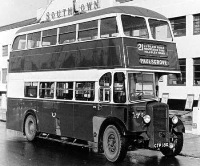 Vehicle reminder shot for this posting
Vehicle reminder shot for this posting
17/03/21 – 06:40
By pure chance, I recently came across a photo of 179 wearing its original austerity H30/26R Duple body, the only one I’ve ever come across of any of these nine 1944 vehicles. As ever, being a Portsmouth Corporation vehicle, it looks impeccable. It is wearing a non-standard nearside headlamp. These vehicles were retro-fitted with rear destination boxes and blinds: most unusual. No doubt Michael Hampton can say where the other terminus of the M/N bus route was.
Chris Hebbron
17/03/21 – 15:59
What a great photo Chris, at The Hard terminus I think. At this time the M/N terminus was at Farlington – a layby on the Havant Road at Rectory Avenue near the City boundary. The route was extended to the new housing estate at Leigh Park in 1949 and renumbered in the 148 group in 1955.
Patrick Jennings
18/03/21 – 06:35
Yes, Patrick, it is The Hard, which I forgot to mention in my eagerness to get the photo posted! Thx for the route details. I only recall it as the 143 route, moving to Pompey in 1956.
Chris Hebbron
19/03/21 – 12:14
Yes Chris, I can inform of the M/N service of Portsmouth Corporation. The bus is indeed at The Hard, but we never called it that in those days [although it was the street name]. It was always "Dockyard", and only in the 1980s did it become known as "The Hard", including on bus destination screens. [As the bus station was built over in the late 70’s / early 80s over the mud flats to make a better connection with the railway and the Gosport Ferry, it became "The Hard Interchange" on bus screens – geographically correct, but hardly a good advert for a new interchange!].
The M/N service came about either during or just after WW2. It ran initially from Farlington [Rectory Avenue] via Cosham, North End, Kingston Crescent, Guildhall, and to Dockyard. There was a pre-war M/N service, but that was a completely different item, with nothing in common. In 1949, the M/N service was extended to Leigh Park [Botley Drive], as this was an expanding council estate on the outskirts of Portsmouth – the largest in Europe at one time. There had been plans for it to become a trolleybus service, and T/B route 1/2 would have replaced it. Authorisation was given, but it was never carried out.
In 1955, the service M/N was renumbered 148, to link in with Southdown routes in that direction. 148 ran to Farlington, 148A ran to Leigh Park [Botley Drive], and 148B ran to Leigh Park [Crondall Avenue]. As the buses of the 1950s/60s just displayed "Leigh Park" as a final destination. you had to squint at the number to see if it was a 148A or 148B! This of course all changed with the advent of deregulation and the ending of the Portsmouth / Southdown co-ordination agreement.
I must have seen these Daimlers with their utility bodies, but don’t remember them. I only remember them with their Crossley bodies which were fitted in 1955. I remember them being used on the 21, the O/P, and the 3/4 [ex-trolleybus] routes, though they could turn up on other routes too – e.g. the 145 another route renumbered from R/S to link with Southdown routes heading west.
Michael Hampton
21/03/21 – 07:22
I have a slight correction to the above notes on the M/N service. Trolleybus route 1/2 was introduced in 1936, operating from Cosham Red Lion to Clarence Pier. During wartime there were a number of variations, including diversion to South Parade Pier, Dockyard, Eastney and elsewhere. By 1945 it had settled back to Clarence Pier. However in Sept 1946 it was diverted back to Dockyard. Then on 18/ May 1947 it was withdrawn and replaced by service M/N which was extended from Cosham to Farlington. The intention was to extend the trolleybus wires along Havant Road to Farlington, and convert it back to trolley operation as 1/2. However, this never happened, and the route’s history is as I described earlier. With the extensions into Leigh Park, the Farlington [Rectory Ave] destination was then always only a rush-hour short working.
Michael Hampton
27/03/21 – 06:17
Thx, Michael, for all that background information in your two posts, most of which I wasn’t aware. Your mention of mud reminds me of the Mudlarks of the 50s/60s; boys who used to paddle in The Hard mud searching for the coins which passers-by threw to them. The most confusing destination to me was Floating Bridge, which was mysterious to folk like us holidaymakers, before my family settled in Portsmouth and saw the ancient chain ferry crossing to and from Gosport from the High Street. The Corporation were lucky to get Duple-bodied austerity vehicles, probably the soundest bodies of the non-metal type. I recall that a ‘public-execution’ scenario loomed on one occasion, when Duple refused one delivery of a pile of green wood which they insisted was of unusable quality for bodybuilding! I’m not aware of Hants and Sussex getting austerity buses, and Provincial only had the one Regent/Regal which Reading bodied, their sole wartime effort. How about Hants & Dorset/Southampton Corporation?
Chris Hebbron
28/03/21 – 07:50
Thanks Chris for your note, especially the comment on Duple’s reaction to green wood! I read in a book a long time ago, that some wood was so green, that if the company livery was green, there was no need to paint the bus!
Hants & Sussex had two utilities, one was LDO51, ECG616, which was a Leyland TD7 with Brush UH56R body, new in 1942, and lasting until 1955. The second was GDO50, a Guy Arab I with Park Royal H56R body, new in 1943, and lasting until 1951. The fleet number looked very grand, but apparently meant nothing except to impress the uninitiated! [Presumably the letters meant Leyland [or Guy], Double-deck, Oil engine].
I think Provincial had other utility Guy Arabs, but haven’t had a chance to check my books yet. Also Southampton Corporation had utility Guy Arabs, but I don’t know the quantities. Corgi produced a model of one in their Original Omnibus series, and I have one of these with all the other 35 or so utilities sitting on my shelf! I don’t know what Hants & Dorset had. Will have to check.
Michael Hampton
30/03/21 – 05:23
Well Chris, I’ve been looking up a few things in books or on line! Utilities along the Solent? – quite a few! Here’s what I found [part 1] –
Hants & Sussex – [PSVC fleet history PK21, 2020]
LDO51 [ECG 616]; Leyland TD7 / Brush UH30/26R entered service Feb 1942, and withdrawn Feb 1955. It was on loan to Cardiff Corporation 11/47 to 5/49. After sale it was later converted to a lorry in 1957, and then with a showman until 1962.
GDO50 [EHO 586]; Guy Arab [5LW] / Park Royal UH30/26R entered service Feb 1943 and withdrawn Oct 1951. It was also on loan to Cardiff Corporation 11/47 to 5/49. In 1950 it received an engine and gearbox from an ex-Plymouth Dennis Lance, one of several acquired by Williams in 1944. By April 1953 this Guy was derelict at the Emsworth garage, minus engine, and was scrapped on site later.
Hants & Dorset
Hants & Dorset were only allocated twenty utilities to their fleet in war-time. These were –
CD950-952 [FRU 7-9]; Guy Arab I / Strachan UL27/28R [1942] TD768-770 [FLJ 976-978]; Bristol K5G / Strachan UL27/28R [1942] TD771 [FRU 11] Bristol K5G / Duple UL27/28R [1942] CD953 [FRU 10]; Guy Arab I / Strachan UL27/28R [1943] CD954 [DCR 865]; Guy Arab I / Brush UL27/28R [1943] CD955-958 [DCR 866-869]; Guy Arab I / Roe UL27/28R [1943] TD772-773 [FRU 303-304]; Bristol K6A / Strachan UL27/28R [1944] TD774-778 [FRU3 05-309]; Bristol K6A / Strachan UL27/28R [1945]
All of these were re-numbered in the series 1093-1112 in 1951 when H&D got rid of their “class” system. All the Guys were at least re-seated, and some rebuilt early post-war, but were withdrawn between 1953-1956, some going on to serve with independents around the country. All the Bristols were re-bodied, some with new bodies, some with older pre-war stock transferred. Some became open-toppers – a complex set of events over more than one generation of vehicles. All the Bristols were withdrawn between 1959 and 1969.
Southampton Corporation
Southampton ran a fleet of pre-war Guy Arab FD buses of the original style, although they later switched to Leyland TD4s and TD5s. Their post-war fleet was totally Guy Arab III with Park Royal bodywork [until some Albion saloons in 1957]. This post-war influx saw off all the pre-war Guys and Leylands. However I find that Southampton received just 8 utility Guy Arabs, but my source gave no details. I believe from what I read years ago that these utilities were withdrawn when the final Arab IIIs were purchased in 1954/55. The Corporation had persuaded Guy to produce a few final Arab IIIs, even though the Arab IV was by then the standard model.
End of Part 1 – …..
Michael Hampton
30/03/21 – 05:24
And here is part 2 for Solent area utilities – all on Provincial –
Provincial [Gosport & Fareham] – [The Gosport & Fareham Story, Patrick Miller, TPC 1981]
54 [ECG 622]; Bristol K5G / Park Royal UH30/26R new 1942. Converted to O30/26R in 1952, withdrawn 1969. This was the only Bristol owned by Provincial until after the end of the Orme-White era.
55 [EHO 228]; Guy Arab I [5LW] / Weymann UH30/26R, new 1942. It was re-bodied by Reading H30/26R in 1955. Note – this was NOT a full-front re-body, nor was it a Deutz engine conversion. It was the only Mk I Arab bought new by Provincial. It still exists, and the Provincial Society has launched an appeal to secure it for their collection.
56-61 [EHO 868-870/965/67/66]; Guy Arab II [5LW] / Park Royal UH30/26R, new 1943. Of these, 56 was converted to O30/26R and ran until 1969. 57 was re-bodied by Reading in 1953 to CO30/26R. This was known at the time as the “coach bus” due to it’s seats and interior fittings. It also still exists as part of the Provincial Society’s collection. It is thought that it was never used in service in open-top form, but it’s not known whether the roof was ever raised in the depot, just to “see if it works”.
58 was re-bodied by Reading FH30/26R in 1962, and given a Deutz air-cooled engine. It was renumbered 75, and lasted until 1972. 59 had the same treatment in in 1958, but retained it’s original number, and ran until 1970. 60 became an open-topper in 1952, and was then re-bodied in 1956 by Reading as FH30/24RD, but was not a Deutz conversion. 61 was dealt with in 1959 with a new Reading FH28/26R body and a Deutz engine, lasting until 1970.
17-18/31-32 [EOR 875-878]; Guy Arab II [5LW] / Park Royal UH30/26R, new 1945. Of these, 17 was re-bodied Reading FH30/26R in 1958, but was not a Deutz conversion. It became No 28 in it’s final year, and withdrawn in 1971. 18 was rebuilt to O30/26R in 1955, and was withdrawn in 1969. 31 was rebodied by Reading FH30/26R in 1961, and converted to Deutz engine, being renumbered 73. It’s end came in 1971. 32 was re-bodied by Reading FH30/26R in 1957, but not re-engined. It became 27 in 1970, being withdrawn in 1971.
Then there are the two “specials” – certainly utility bodies, but the chassis were another matter! In 1943, there was an AEC Regal chassis of 1932, acquired from the War Dept. It may have been new to Yelloway, Rochdale. It was fitted with a Reading UH30/26R body and re-registered EHO 282, and numbered 15. This was Reading’s first double-deck body. It ran until 1959, when the body [modernised 1952] was transferred to 12, a post-war AEC Regent II. The chassis disposal isn’t known by me, but may have been used for “spares” in the common Provincial way.
The other “special” was an AEC Mandator chassis, new 1932. Provincial converted it to forward control, and had Reading fit a UH30/26R body to it. It became 14 [EOR 251]. It ran in this form until 1960, with the body modernised in 1952. This body was transferred to AEC Regent II No 11 in 1961. Again, chassis disposal is “unknown” by me.
These are the utilities bought new by Provincial, and as we can see were operating, usually in modified form in to the 1960s and 70’s.
There were two other utilities operated later by Provincial, one of which was 72 [HHA 84], acquired from Midland Red [2589] in 1957, a Guy Arab II [5LW] with a BMMO-modified NCME body [UH30/26R]. After use in this form, this was re-bodied by Reading FH30/26R in 1964, and fitted with a Deutz engine, retaining No 72. It ran in this form until 1971. The other Guy Arab II was acquired from a contractor in Gosport! It had been new in to London Transport as G276 [GYL 416], in 1946 and, fitted with a new Reading FH30/26R, and a Deutz engine, became 33, [CHO 449C]. It’s noted in other material, that this was the only London utility to be rebuilt and/or re-bodied to re-enter service with a year-suffix registration! After re-numbering to 61 in 1970, it was withdrawn in 1972.
So Provincial had 12 utilities bought new [11 Guy, 1 Bristol], plus two “odd-ball” machines which had utility bodies. Through their various rebuild and re-body programmes, many of these lasted until the end of the Orme-White era in 1969/70. And there were the two second-hand acquisitions mentioned above, also similarly rebuilt. I haven’t covered the others acquired, being non-utilities, which was the focus of the original question. The fleet list I’ve used also mentions that some of the other Guy Arabs acquired c.1962/63 were Arab IIs, but these came from dealers, and chassis attributed to a 1947 date new, with no detailed notes on their origins. These may or may not have been utilities, but only saw service in modified form, and re-registered.
That’s all I can find for now…! – There was also King Alfred [Chisnell’s in Winchester, who had a few utilities, too. So maybe a little bed-time reading is in store.
Michael Hampton
30/03/21 – 10:31
Provincial bought one utilty Guy which originated in the Red & White fleet. Red & White 467 (EWO 467) was new in October 1942 with a L27/28R body. In 1951 it had its bonnet modified to the Arab III profile and was rebodied with a BBW L27/28RD body. Withdrawn in October 1963 it passed to Howells and Withers at Pontllanfraith, being sold to Provincial in February 1965. It became 77 in that fleet but is not believed to have entered service until October 1965.
Withdrawn in 1970 it passed through a succession of preservation owners, but sadly the body deteriorated to the extent that it is now on display in the museum at Barry as just a chassis/cab.
David Beilby
31/03/21 – 06:27
Extra note on King Alfred [R Chisnell & Sons, Winchester] utilities
Before WW2, King Alfred operated a wholly single-deck fleet in their area [apart from a mystery second-hand Thornycroft J bought from Southampton in 1925 and disposed of in the same year]. The demands of service personnel based in the area brought increased demands, and the following utility buses were allocated to the company.
ECG 639 – Leyland TD7 / Brush UL27/28R, new 1942, withdrawn 1953. Sold 1954 to contractor Faulkner’s of Waterlooville.
EHO 130 – Guy Arab I 5LW / Brush UL27/28R, new 1942, withdrawn and sold 1952. EHO 131 – Guy Arab I 5LW / Brush UL27/28R, new 1942, withdrawn 1951, converted to tree-lopper 1953, disused from 1964, sold for scrap 1967.
EHO 686 – Guy Arab II 5LW / Strachans UL27/28R, new 1943, withdrawn and sold 1951 to Creamline, Bordon.
EOR 579 – Guy Arab II 5LW / Weymann UL27/28R, new 1944, withdrawn 1954, sold 1955.
EHO 132 – Bedford OWB / Duple UB32F, new 1942, withdrawn 1955, disposal unknown.
EHO 133 – Bedford OWB / Duple UB32F, new 1943, withdrawn 1952, sold 1955.
Also added later – FRU 149 – Bedford OWB / Duple UB32F, new to Charlie’s Cars, Bournemouth 1943, acquired by King Alfred 1947, withdrawn and sold 1951. Later re-bodied and lasted with others until 1962.
FRU 150 – Bedford OWB / Duple UB32F, new to Charlie’s Cars, Bournemouth 1943, acquired by King Alfred 1947, withdrawn and sold 1951. Later converted to a horsebox.
These were acquired to boost fleet demands in the immediate post-war period, while pre-war stock was being refurbished, and delivery of new stock awaited. They initially operated in Charlie Car’s brown livery.
There were several other local operators in the Winchester area at the time, and one, Greyfriars [Winchester] had Bedford OWB registered EOR555, new in 1943, and still with them in 1953. There may have been other Bedford OWBs in the area, too – there certainly were across Hampshire, but only Aldershot & District had Guy Arabs and Leyland TD7s in utility form. No-one else apart from Portsmouth seemed to have Daimlers in the Hampshire area, although Wilts & Dorset had a few which might have ventured into some parts. Of course, Bournemouth Corporation was still in Hampshire then, and they had some Guy Arab utilities, some of which survived for longer periods as open toppers, and one even became an open top single-decker.
I hope all this info is of some interest!
Michael Hampton
Quick links to the - Comments Page - Contact Page - Home Page



